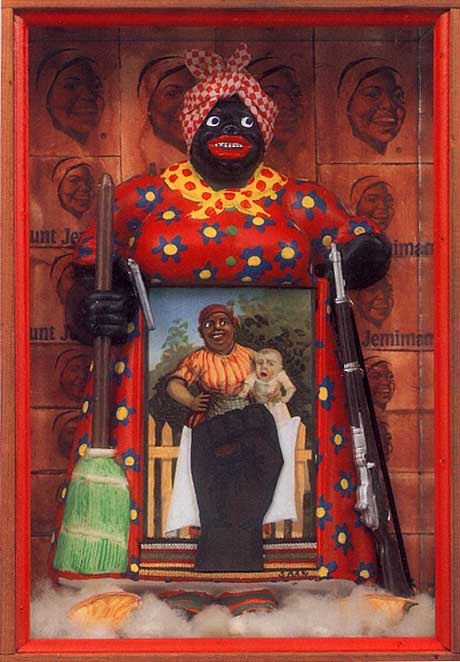WOMAN OF THE MONTH:
 BETYE SAAR DOES BOXES
BETYE SAAR DOES BOXESBetye Saar is a rock star boxer. No, not the Muhammad Ali kind. I’m talking about the Joseph Cornell variety: assembling materials into small-sized containers (collages!). Inspired by Cornell’s assemblage work, Saar, a lifelong random object collector, realized his boxes were the perfect medium for arranging her own findings, which she could assign deeper meanings to once merged.
Inside Saar’s studio: collage materials
Saar uses Cornell only as a starting point. His boxes tend to employ softer colors and imagery, producing a precious effect. Saar’s boxes, on the other hand, are much darker in tone. There’s nothing precious about her 1972 box, The Liberation of Aunt Jemima. Aunt Jemima’s got a rifle in one arm, and a pointed broomstick and grenade in the other – lady means business. But what’s so disturbing here isn’t the weapons; it’s the early renderings of Aunt Jemima. Audiences are confronted with real imagery of racism and sexism.
Betye Saar, The Liberation of Aunt Jemima, 1972
Part of Saar’s childhood collection were derogatory depictions of blacks in pop culture – what the artist calls her “black heroes.” Talking about the use of her heros in her box art, Saar says, “I like to think I recycled those images from negative to positive. At any rate, it was how I got my anger out.” Get it, girl!
Betye Saar, Pour Vous Madame, 1999
Betye Saar, Lullaby, 1999
Betye Saar, photograph by Robert Hale
__________________________

__________________________

__________________________
#6 Destruction within America
17TuesdayJul 2012
Posted
Betye Saar is an American artist known for her assemblage sculpting skills. Most of her work depicts African-American history, and she uses stereotypical pieces (Aunt Jemima) as political statements. She was born in Los Angeles in 1926 and still lives there.

Duble Duty was created in 1997 in Los Angeles as a piece to represent the times in which women were slaves. Aunt Jemima in this picture is depicted holding a rifle with a broom as a symbol of strength. This piece fits within my theme because it describes in the poem the destruction in which these Americans had to go through. I love collages so I was immediately drawn to this artist, but what I really liked about this piece is the play on words of the Dubl Handi and Duble (double) duty. It places even more emphasis on the work these people had to do.

Ragtime was created in 2005 in Los Angeles and is part of the Migration/Transformation collection in New York City at the Rosenfeld gallery. The New York Times defines the piece in Ms. Saars words as, “An American who gets minstrel or a fool who gets lynched. The R and G is backwards, but so is slavery.” The piece fits within my theme because of the pain that the Civil War period caused on so many people. I really like how this piece seems to define the boy depicted in the picture. It tells a story, of heroism, and sadness.
>via: http://casavel13.wordpress.com/2012/07/17/6-destruction-within-america/




